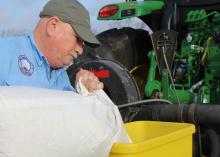Seed treatments protect crops from early harm
STONEVILLE, Miss. -- When managing insects and diseases in row crops, growers typically act after a problem appears, but there are no reactive treatments for some pests, including soil insects that attack seeds and developing seedlings.
Management such as seed treatments or in-furrow insecticides for these pests has to be applied at the time of planting. Mississippi State University researchers say seed treatments make good sense for many crops.
“Sometimes, it can be difficult to see the results of seed treatments,” said Don Cook, an entomologist at the MSU Delta Research and Extension Center in Stoneville. “For example, all commercial corn seed has an insecticide seed treatment. Therefore, there are no ‘untreated’ fields to show what could happen with a bad insect infestation.”
Seed treatment is a generic term that describes anything put on the outside of a seed to provide some type of benefit.
“Insecticide treatments help protect from insects in the soil that could attack that seed or developing seedling plant,” said Cook, a Mississippi Agricultural and Forestry Experiment Station researcher. “Fungicide seed treatments help manage diseases that may attack the seeds and seedlings. Some seed treatments offer protection against nematodes.”
Many row crop seeds today come with treatments, and the type can vary with the crop. Most seed suppliers offer different packages that include different numbers and types of products. Cost varies with the treatment package, and it increases as more or different products are added.
“In Mississippi, the probability of infestations of soil and seedling insect pests can be fairly high for crops such as soybean and corn, and there are production practices that can increase this risk,” Cook said.
Seed treatments can be especially useful when seeds are planted in conditions that are less than ideal, such as early in the season when the ground is cool and often wet.
“These conditions slow the seed germination and plant development, keeping it susceptible to damage from soil and aboveground insect pests longer,” he said. “Seeds planted into fields with a lot of plant residue or live vegetation often benefit because there is usually increased insect pressure.”
Yield responses and subsequent economic returns from seed treatment use can vary. Many factors determine the impact of treatments, including type of crop, planting date, weather conditions, and field history.
“There are situations and conditions that increase the risk of having a problem,” Cook said. “In many cases, a grower may not need a large yield response to pay for a seed treatment. Over the last 15 years, our data indicates there is a fairly high probability that using an insecticide seed treatment will be profitable.”
Cook said the development of seed treatments that performed close to or better than in-furrow products drove seed treatment adoption.
“This allowed for the convenience factor,” he said. “Treated seed results in an easier, faster planting operation. The grower only has to load seed in the planter instead of seed plus one or two granular products in separate hoppers. Without the granular product hoppers, planters could carry bigger seed hoppers, reducing the number of times the tractor had to be stopped to refill seeds.”
Tom Allen, MSU Extension pathologist and MAFES researcher, said fungicides are the most common seed treatments used and were among the first seed treatment products developed and commercially marketed.
“Regardless of crop, the two most important organisms that are managed effectively with the proper seed treatment are members of the genus Pythium and Rhizotonia solani,” Allen said. “Several different seed treatment chemistries perform well against these two organisms, and when used, can prevent stand losses that result from the two classes of soilborne organisms.”
Allen said seed treatments are essentially a form of cheap insurance.
“Their use can reduce the likelihood of catastrophic stand failures that can occur if the environment that follows planting shifts towards something more conducive for seedling diseases to occur, which generally means cool and wet conditions,” Allen said.
MSU and other Midsouth land-grant universities evaluate crop protection products in order to provide growers the most up to date and accurate information for pest management.
For more information from MSU specialists on various aspects of row crop production, visit .









